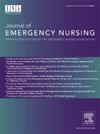建立分流能力和验证流程:调查研究。
IF 1.8
4区 医学
Q2 EMERGENCY MEDICINE
引用次数: 0
摘要
导言:尽管急诊室分诊功能是确保患者安全的重要手段,但文献中并未对急诊室分诊的核心能力做出明确定义。本研究旨在确定和验证急诊分诊护理能力,并制定能力验证流程:方法:1181 名急诊护士完成了一项在线调查,对能力要素进行评估,这些能力要素包括以下方面的频率和重要性、培训模式和评估方法:专家评估、临床判断、医疗资源管理、沟通和及时决策:结果:主管级护士和分诊护士都认同所确定能力的重要性。员工级护士和管理级护士都报告了培训和评估方面的差距。与经理级护士相比,分诊护士的培训和能力评估较少。与经理级护士相比,分诊护士在报告分诊护士表现时更频繁地报告了所有能力,能力水平也更高:本研究提供了一套标准的分诊能力和评估方法。管理者和教育者可以考虑采用这一标准来建立分诊角色的初始能力,并根据机构指南定期进行能力评估。教育和评估方面的差距表明,急诊科应采用标准的教育和评估流程。本文章由计算机程序翻译,如有差异,请以英文原文为准。
Establishing Triage Competencies and Verification Processes: A Survey Study
Introduction
Although the ED triage function is a critical means of ensuring patient safety, core competencies for ED triage are not well defined in the literature. The purpose of the study was to identify and validate emergency triage nursing competencies and to develop a competency verification process.
Methods
A sample of 1181 emergency nurses evenly divided between roles with oversight of triage training and competency assessment (manager-level and staff nurses performing triage) completed an online survey evaluating competency elements that comprised the following in terms of frequency and importance, training modalities, and evaluation methods: expert assessment, clinical judgment, management of medical resources, communication, and timely decisions.
Results
Both manager-level and triage nurses agreed on the importance of the identified competencies. Gaps in training and evaluation were reported by both staff nurses and manager-level nurses. Triage nurses reported less training offered and less competency evaluation compared with manager-level nurses. Triage nurses reported performing all competencies more frequently and at higher level of competency than manager-level nurses reporting on triage nurse performance.
Discussion
This study provides both a standard set of triage competencies and a method by which to evaluate them. Managers and educators might consider this standard to establish initial triage role competency and periodic competency assessment per institutional guidelines. The gap in perceived education and evaluation suggests that standard education and evaluation processes be adopted across emergency departments.
求助全文
通过发布文献求助,成功后即可免费获取论文全文。
去求助
来源期刊
CiteScore
3.10
自引率
11.80%
发文量
132
审稿时长
46 days
期刊介绍:
The Journal of Emergency Nursing, the official journal of the Emergency Nurses Association (ENA), is committed to the dissemination of high quality, peer-reviewed manuscripts relevant to all areas of emergency nursing practice across the lifespan. Journal content includes clinical topics, integrative or systematic literature reviews, research, and practice improvement initiatives that provide emergency nurses globally with implications for translation of new knowledge into practice.
The Journal also includes focused sections such as case studies, pharmacology/toxicology, injury prevention, trauma, triage, quality and safety, pediatrics and geriatrics.
The Journal aims to mirror the goal of ENA to promote: community, governance and leadership, knowledge, quality and safety, and advocacy.

 求助内容:
求助内容: 应助结果提醒方式:
应助结果提醒方式:


